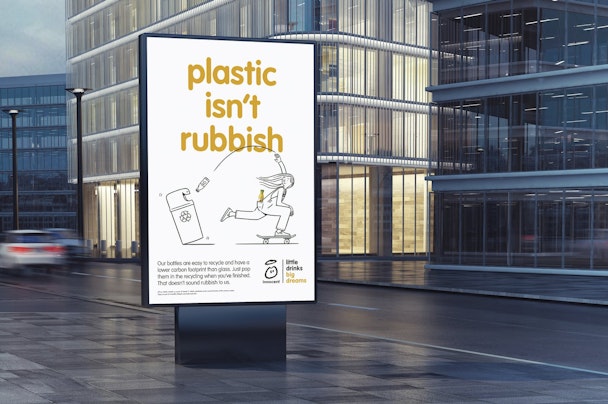Is creativity the enemy, or the solution to greenwashing?
Since the CMA’s Green Claims Code came into effect at the start of this year, an increasing number of brands are falling foul of guidelines designed to crack down on greenwashing in advertising. Innocent Drinks is the latest to come under scrutiny after activists filed a complaint with the ASA. Here, Duncan Reed of UK law firm TLT explains what brands must do to ensure they remain above board.

Innocent Drinks is the latest brand to come under scrutiny
The Innocent ‘Little Drinks, Big Dreams’ ad campaign and TV commercial is one of several in a growing line of cases where the ASA has to decide what constitutes greenwashing.
This case gives rise to several important questions for brands and agencies, as the various regulators – including the ASA, Trading Standards and the Competition and Markets Authority – roll up their sleeves and start to lean into the task of cracking down on greenwashing.
These questions include: where do regulators draw the line in terms of what brands can and can’t say? What’s the impact of still using single-use plastics, or running diesel fleets, alongside their more environmentally-friendly credentials? How can creatives design a slick ad while also giving consumers the information they need to make an informed decision about what they choose to buy?
Is creativity the enemy, or the solution to greenwashing?
Time for change
The CMA’s own research reveals that green claims are becoming increasingly influential over consumers’ purchasing decisions. It also found that up to 40% of green claims are either unclear or unsubstantiated and likely to be misleading and warranting further investigation.
Meanwhile, our recent survey of the UK’s top 100 retailers found that three quarters (73%) believe consumers misunderstand claims about sustainability, with a fifth (20%) suggesting they do so ’often’. And only 16% of retailers are ’very confident’ they will meet the CMA’s expectations when it conducts a full review of green claims this year, falling to just 10% of grocers.
Clearly, the proliferation of generic language about being green, sustainable, good for the planet etc has highlighted a major challenge with applying consumer law in this area.
The regulators have published detailed guidance and done a lot of publicity in recent months to help brands understand what they expect when it comes to substantiating claims. The message is loud and clear: greenwashing is rife and change is needed. They will be reasonable in their application of the law, of course, but many brands will be surprised by how far they are expected to go.
Brands must read the guidance and check whether or not their claims – meaning everything that is on the market, eg on websites and packaging, and any work in progress – meet the requirements, and that they can substantiate this if the regulator comes knocking. They must review and update their processes, and offer appropriate training to in-house and agency teams.
Creative solutions
The temptation for brands these days is to tell consumers that they’re aligned with ESG values and position themselves as a sustainable business. According to our survey, 62% of retailers are feeling the pressure to make their position on sustainability more visible, and 59% are becoming more vocal, despite 52% admitting it’s impossible to know if they’re doing enough to say they’re sustainable.
As a result, a fifth (21%) of retailers are what we called ’high risk’, ie shouting more loudly but not confident about the CMA’s impending review. The majority (41%) are not yet shouting more loudly and will need to ensure they understand the law before entering the fray.
This isn’t the first time the law has come into conflict with the principles of great advertising. Beauty adverts claiming scientific benefits often carry small print; investment adverts caveat their claims with a warning that investments can go up as well as down; adverts often end with rapidly-spoken small print and instructions to check terms and conditions, for example, in order to tow the line.
With companies increasingly needing to publish their environmental policies and performance online, there will arguably be more places where consumers can go to check if a company meets their requirements and black list them if they fail to meet the grade. However, the question will always remain – was a particular advert misleading in the eyes of a reasonable consumer?
The CMA has published six principles and a list of 13 questions to which the answer must be yes for every green claim a brand makes. The CMA has a range of measures it can use as it carries out its review this year: formal investigations, published undertakings where brands have previously failed to meet their requirements and – in the case of serious breaches – prosecutions. Agencies that can satisfy both their client’s brief and the regulators stand a lot to gain in protecting their client’s reputation.
It’s worth noting that there is also a risk of significant and brand-damaging fines on the horizon. The Department for Business, Energy and Industrial Strategy is consulting on proposals to give the CMA the power to impose a penalty of up to 10% of turnover for consumer law breaches and 1% of turnover for non-compliance with information-gathering powers.
Ultimately, the CMA is looking to give businesses that are genuinely investing in innovation in sustainability the ability to make claims in confidence and to gain a competitive advantage from this. While the recent guidance might feel like a significant step-change, the lines on greenwashing are becoming clearer and consumers are only going to become savvier in the coming years. There are significant advantages for brands and agencies that can get this right.
Duncan Reed is regulatory partner at UK law firm TLT.
